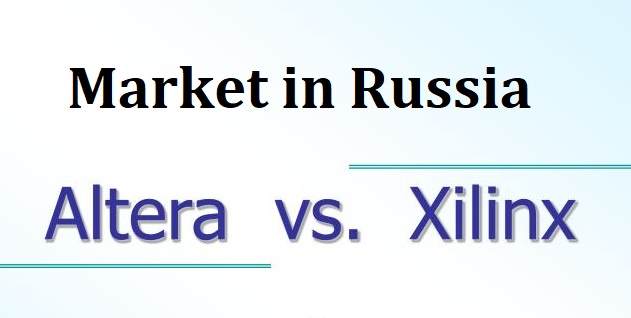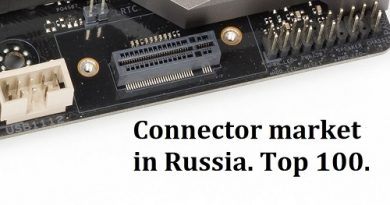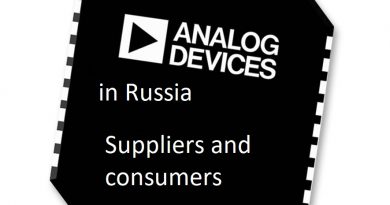Altera and Xilinx Market in Russia. FPGA.
I have long wanted to write an article about the programmable logic market (FPGA), or to be more precise, about the brands Altera and Xilinx. My interest is due to the fact that about 18 years ago I started developing Altera sales in Russia. We were not distributors, but we found access to distributors in China. Everything turned out so good that when a representative of Altera came to us many years later to discuss the terms of distribution, the company, not being a distributor, was the second in terms of sales in Russia. The latest news that AMD is buying Xilinx reminded me of this desire.
According to the forecasts of analysts, FPGA sales will reach $9.1 billion in 2026, which significantly exceeds the amount of $6.2 billion in 2021 (MarketsandMarkets data). The average annual sales growth is 7.8%. The main growth factors are the deployment of data centers and high-performance computing, the introduction of artificial intelligence (AI), and the Internet of Things (IoT).
Globally, the two companies share most of the market.
Altera is an American company that existed in 1983-2015, a fabless manufacturer of FPGA. In June 2015, it was absorbed by Intel Corporation for $16.7 billion. After the merger of Intel and Altera, the division Intel PSG was formed within Intel, in which all Altera competencies were concentrated. After the takeover, Altera ceased to develop as an independent company, as evidenced by the fact that its website and domain are no longer functioning. PSG division occupies 2.6% of Intel’s total sales.
Xilinx is an American developer and manufacturer of integrated circuits of programmable logic (FPGA). On October 27, 2020, an agreement was signed to merge AMD and Xilinx. According to the company’s statement, it occupies 51% of the global FPGA market. The second is Altera, with a share of 34%, and Lattice Semiconductor is in the third place, with a large gap from the leaders.
I took the sales data shown in Table 1 (in billions of dollars) from open sources.
Table 1. Sales data of FPGA leaders in the world.
| 2018 | 2019 | 2020 | |
| Xilinx | 2.4 | 3 | 3.1 |
| Intel | 2.1 | 2 | 1.9 |
| Lattice Semiconductor | 0.28 | 0.4 | 0.4 |
Interestingly, two uncompromising competitors were bought by two other irreconcilable competitors. From a market point of view, everything is logical: the market of solutions for servers and data centers is strategic for both companies. The loss of competitive advantages on it is unacceptable.
Three companies in Table 1 control the entire market, and we will analyze them. Other players owned in 2020 insignificant shares at the global market and zero in the Russian one. Let’s list these companies: Microchip Technology Microsemi, QuickLogic (US), TSMC (Taiwan), United Microelectronics (Taiwan), GLOBALFOUNDRIES (US), Achronix (US), S2C Inc (US), Efinix Inc. (US), Flex Logix Technologies (US), GOWINSemiconductorCorporation (US).
So, in 2020, the real position of the market in Russia was distributed according to Table 2.
Table 2. The Russian market of global leaders in FPGA.
| Manufacturer | Result |
| INTEL | 2,170,464 |
| INTEL/ALTERA | 12,451,674 |
| XILINX | 75,406,377 |
| LATTICE | 155,437 |
| Total result | 90,183,952 |
Two companies hold leading positions and make up the main market share. Other firms, including LATTICE, will not be considered in this review article.
With XILINX, everything is simple – it is an independent company, its import is not difficult to see and calculate. ALTERA has ceased to exist, but many importers still use this brand when importing. In the second line, where the manufacturer INTEL/ALTERA is indicated, the final digit consists of import data, in which the brand ALTERA, the words FPGA or PSG division were specifically used. To get the correct data, I had to use various combinations of names and phrases.
The import figure in the first line of INTEL is obtained in a more complicated way. After processing the information and calculating the import of the manufacturer INTEL/ALTERA, I had more than $100 million left under the brand INTEL. I deleted the lines with keywords such as processors, microprocessors, converters, deleted all IT distributors, as well as everyone who was not in the list of decrypted importers working at the component market. As a result, the figure that you see in the first line has remained. It contains the supplies of the brand INTEL namely, without specifying keywords (ALTERA, FPGA, etc.), those importers, including former distributors who work at the component market and were highlighted in my earlier articles.
After the above actions, I had a list of companies that were not 100% players at the component market. They imported the brand INTEL under three key HS codes, XILINX is 95% imported by these codes, for $6.5 million in total. This is the amount that cannot be unambiguously attributed to INTEL processors, but they do not contain an unambiguous sign, for example, the words FPGA, except for the customs code. I will give only 4 companies from this list for example, in random order: GEOTECHNIKA, LLC , ELCO RUS, LLC, MARSALA, LLC, NEW IT PROJECT, LLC.
As you can see, these are all IT distributors. I do not attribute this import to FPGA, but I must give this figure so that you understand why my results may not coincide with the figures that you may have. I say again, I am not sure that these companies imported FPGA products, so I do not consider it necessary to analyze this figure and enter it in Table 2. In total, the brand INTEL/ALTERA imported $14.5 million to Russia. I can’t say that this figure is reliable, this is the minimum amount, and the real one is most likely 1-2 million more.
It should be noted that back in 2017 the situation was radically different. Why in 2017? The takeover deal was announced in mid-2015, 2016 was the time of preparation, and 2017 was a turning point.
Deliveries were still carried out under the old conditions, if INTEL managed to revise them, then the new ones were just beginning to have an impact on the Russian market. In 2017, approximately $50 million of imports accounted for ALTERA and $40 million for XILINX.
Such a disparity, in 2017 and 2020, greatly puzzled me. At first I thought that my generalized data on ALTERA and INTEL were incorrect, and decided to test the algorithm on two official distributors of ALTERA (which were in 2016).
The summarized data are presented in Table 3.
Table 3. Sales of official ALTERA distributors according to this status from 2016, thousand USD.
| distributor 1 | distributor 2 | |||
| 2017 | 2020 | 2017 | 2020 | |
| ALTERA | 4,999 | 707 | 1,742 | 307 |
| XILINX | 58 | 112 | 52 | 50 |
| INTEL | 0 | 832 | 21 | 144 |
| Total sum | 5,057 | 1,651 | 1,815 | 501 |
I visited the INTEL website, these companies, as early as 2016, were exactly the distributors of ALTERA, but they were not listed on the INTEL distributors’ page. This is important; both companies are not listed on the website of INTEL as direct distributors. Most likely, they had the status of a sub-distributor or similar, and, undoubtedly, all competencies remained. I should note that these are all imports of former distributors, including processors, in a word, everything that INTEL supplied to Russia.
Table 3 shows a huge drop in sales. I do not know what caused this: the increase in prices, the destruction of supply channels, or the mass decommissioning of popular product families in Russia. It is important that this destroyed the established and competitive business model, which led to a wholesale transition of customers to XILINX and the loss of competitiveness of ALTERA as a whole.
Just look at the figures for ALTERA in 2017. PSG division, formerly ALTERA, accounted for 2.6% of Intel’s total sales, and the share of Russia in ALTERA’s (PSG) sales was 2.5%, half of which were indirect deliveries, not through official distributors.
The management of INTEL has not regulated anything. What is the result? The market has remained approximately at the same level, the shares have changed dramatically. My personal opinion is that AMD will do the same after buying XILINX; they will not delve into the intricacies of our market and will cut the current supply channels at their discretion.
So, in 2020, the import market of Altera and Xilinx in Russia was $90 million. Next, I will divide each brand into 2 groups: brokers and manufacturers. In both cases, the data is reliable, only suppliers-brokers and manufacturers with websites (if any) that I have determined are considered. Both groups work in the component market. Contract manufacturers, transport companies, and brokers are not represented in the tables. Under brokers, I mean all intermediaries, including distributors.
Under the rest – all the importers I have determined; they did not get into TOP 15.
Table 4. TOP 15 ALTERA importers in Russia in 2020.
| Brokers | Result | Manufacturers | Result |
| 1 | 1,700,525 | 1 | 1,059,046 |
| 2 | 830,045 | 2 | 439,286 |
| 3 | 649,323 | 3 | 302,094 |
| 4 | 414,023 | 4 | 230,022 |
| 5 | 276,611 | 5 | 196,193 |
| 6 | 268,738 | 6 | 151,363 |
| 7 | 266,752 | 7 | 99,521 |
| 8 | 253,943 | 8 | 78,969 |
| 9 | 251,459 | 9 | 70,384 |
| 10 | 243,872 | 10 | 66,054 |
| 11 | 234,953 | 11 | 64,360 |
| 12 | 213,069 | 12 | 47,672 |
| 13 | 206,811 | 13 | 46,821 |
| 14 | 203,337 | 14 | 46,139 |
| 15 | 187,482 | 15 | 31,042 |
| Total TOP 15 | 6,200,943 | Total TOP 15 | 2,928,965 |
| The rest | 3,648,875 | The rest | 160,763 |
| Total sum 12,939,545 | |||
Table 5. TOP 15 importers-manufacturers of XILINX in Russia in 2020.
| Brokers | Result | Manufacturers | Result |
| 1 | 27,524,353 | 1 | 2,787,090 |
| 2 | 7,731,328 | 2 | 2,093,427 |
| 3 | 6,738,701 | 3 | 1,172,752 |
| 4 | 2,618,715 | 4 | 757,500 |
| 5 | 2,259,930 | 5 | 534,660 |
| 6 | 1,532,318 | 6 | 432,457 |
| 7 | 1,159,071 | 7 | 428,450 |
| 8 | 1,035,360 | 8 | 427,514 |
| 9 | 924,860 | 9 | 256,644 |
| 10 | 823,213 | 10 | 244,533 |
| 11 | 614,301 | 11 | 216,017 |
| 12 | 446,855 | 12 | 204,370 |
| 13 | 355,105 | 13 | 195,985 |
| 14 | 319,946 | 14 | 109,003 |
| 15 | 289,242 | 15 | 81,897 |
| Total TOP 15 | 54,373,296 | Total TOP 15 | 9,942,297 |
| The rest | 3,640,918 | The rest | 393,521 |
| Total sum 68350032 | |||
Looking at these tables, we can say with confidence that 80% of imports are carried out by brokers, and if we add global distributors, the percentage will tend to 100%.
If you liked the article, subscribe to get acquainted with the others and see new ones. An interesting article about ceramic capacitors will be published soon; an article about one completely Russian website is planned.



